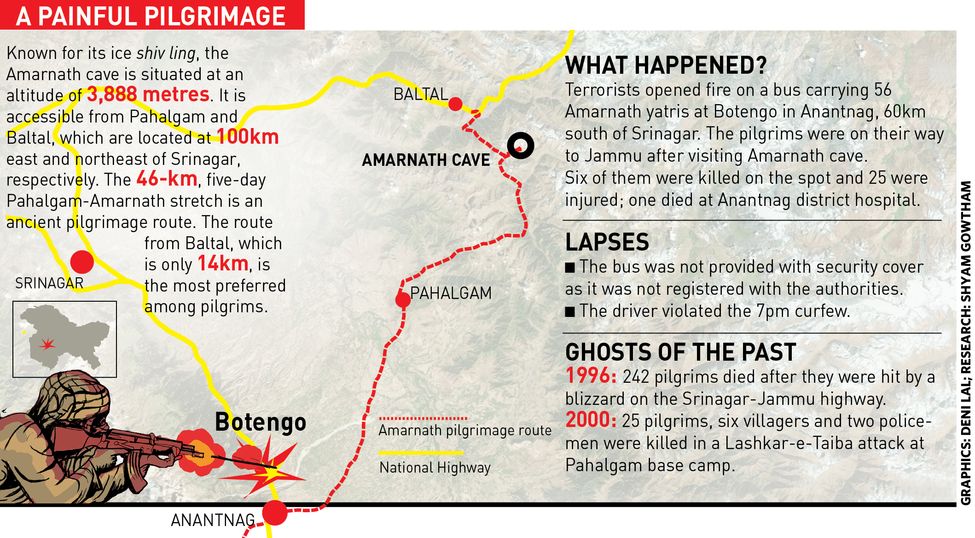 Abu Ismail, the LeT operative who is said to have led the attack.
Abu Ismail, the LeT operative who is said to have led the attack.
In the restive south Kashmir, death anniversaries are often the harbingers of trouble. That is why security forces were mobilised on a war footing when separatists announced a three-day commemoration of the death of Burhan Wani, the Hizbul Mujahideen commander who was shot dead on July 8 last year. Troops swarmed into trouble-prone districts like Pulwama, Shopian, Kulgam and Anantnag, while in Tral, Wani’s hometown, 42 Rashtriya Rifles began an ‘area domination’ operation.
Adding to the Army’s worries was the fact that the 45-day Amarnath pilgrimage season had begun on June 29. Nearly 30,000 troops—from the Army, Central Reserve Police Force, Indo-Tibetan Border Police and Sashastra Seema Bal—were deployed to ensure safe passage for pilgrims.
A few minor protests apart, the commemoration began rather peacefully. There was no repeat of the violent agitation that had spread across the region last year after Burhan’s killing. The security lid, it seemed, had held tight.
On July 10, however, the militants struck. They fired at a bus carrying 56 Amarnath yatris from Gujarat at Botengo in Anantnag, 60 kilometres south of Srinagar. After visiting the cave shrine, the yatris were on their way back to Jammu.
To distract the security forces, the militants had first attacked a police bunker at Botengo. Then they fired at a police patrol at Khanabal, several kilometres away, and attacked the bus carrying the pilgrims. When the police reached the spot, six pilgrims, five of them women, had died; one person died later at the Anantnag district hospital. At least 25 pilgrims were wounded in the attack, which lasted barely a minute.
It reminded everyone of Lashkar-e-Taiba’s attack on Pahalgam base camp on August 1, 2000, in which 25 Amarnath pilgrims, six villagers and two policemen were killed. The condemnation of that attack was so strong and widespread, even among Kashmiri militants, that pilgrims have not been targeted for 17 years.
Until now, that is.
As soon as news of the attack broke, Chief Minister Mehbooba Mufti and her cabinet colleague Naeem Akhtar rushed to the district hospital in Anantnag. “You came here for the yatra and look what we did to you. Maafi, maafi [sorry],” said a visibly shaken Mehbooba, her hands folded. The following day, the victims were flown to Delhi on a BSF plane.
The police have downplayed the attack, saying the militants opened fire at a patrol vehicle and that the yatris were caught in the crossfire. According to Zulfiqar Hussain, CRPF inspector-general, the bus carrying the pilgrims had no security cover, as it was not registered with the authorities. The driver, he said, also violated the 7pm curfew. “Lashkar-e-Taiba is involved and we are working with the police to identify the group,” Hussain told THE WEEK.
Said Muneer Khan, inspector-general of police in Jammu and Kashmir: “Lashkar commander [Abu] Ismail is responsible for this. He is a Pakistani resident.” LeT, however, has denied its involvement.
Ismail, who is in his twenties, is believed to have been the deputy of Abu Dujana, LeT’s Kashmir chief. He reportedly took command of LeT operations after Dujana was sidelined because of his differences with the leadership.

Sources say Ismail is an expert in targeting vehicles on the highway and is now operating in the Shopian-Kulgam stretch. The police said he led the attackers, who came on two motorcycles. “They fired more than 150 rounds before escaping through the maze of lanes and bylanes,” said a source.
Security forces are trying to fathom the reason behind the sudden shift in the militants’ strategy. One possible reason is that targeting pilgrims would put pressure on the ruling alliance of the Mehbooba-led Peoples Democratic Party and the BJP.
Of late, militants have been picking soft targets like political activists and lightly armed policemen. Now, with pilgrims being targeted, the effort could be to stoke communal unrest in the state, especially in the Hindu-majority Jammu division. There is also the possibility of attacks on Amarnath pilgrims sparking off communal riots outside Kashmir.
In Jammu, a bandh was called for to protest the killing of pilgrims. It was supported by Vishva Hindu Parishad, Bajrang Dal, Jammu and Kashmir National Panthers Party, Jammu Chamber of Commerce and Industry and the opposition National Conference. The protesters blocked the Jammu-Kathua national highway.
Already under pressure from the National Investigation Agency, Kashmiri separatists have condemned the attack. In a joint statement, their leaders Syed Ali Shah Geelani, Mirwaiz Umar Farooq and Yasin Malik expressed grief over the killing of Amarnath yatris. “The incident goes against the very grain of Kashmiri ethos,” the statement read. “The Amarnath yatra has been going on peacefully for centuries…. Our heart goes out to the families of the bereaved.”
The attack has forced the authorities to further tighten the security cover in the region. A day after the attack, more than 100 buses carrying around 3,000 pilgrims began their journey to Amarnath from the base camp at Yatri Niwas at Bhagwati Nagar in Jammu. Troops have taken extra precautions to protect the pilgrims. Additional buses have been arranged to ensure that no one gets stranded in case a vehicle breaks down. The convoy reportedly left the base camp at 3am to ensure that it crossed the Jawahar Tunnel on the Srinagar-Jammu highway before 3pm.
The damage, however, is done. The attack on pilgrims has worsened the security situation, and it could well polarise the state on communal lines. The embattled Mehbooba government, it seems, has one more worry to deal with.







